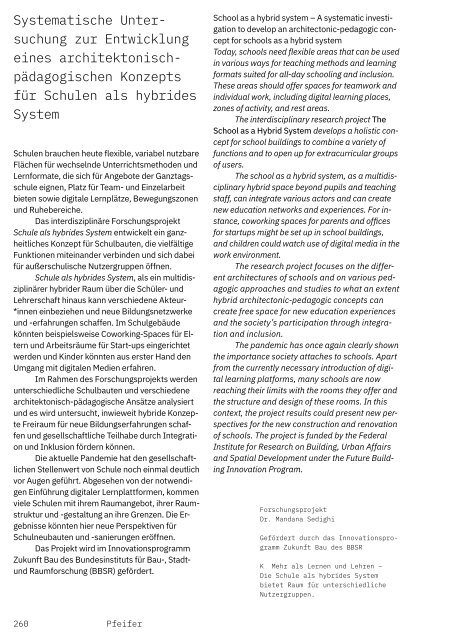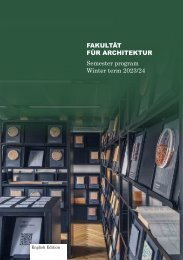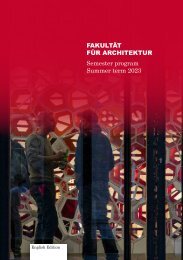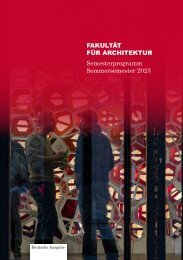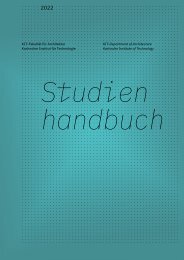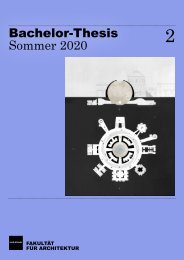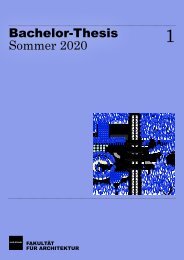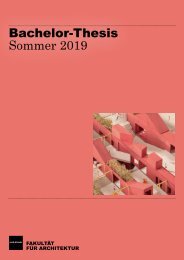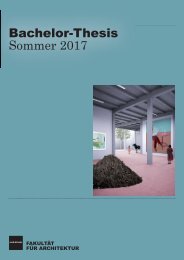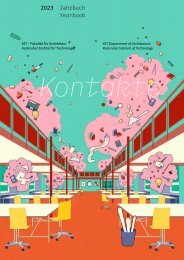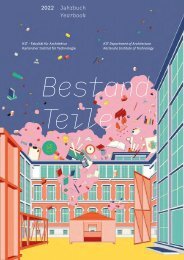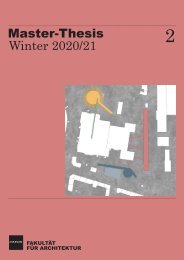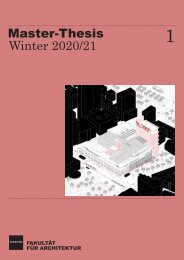Salutogenese – Das Jahrbuch der KIT-Fakultät für Architektur 2021
Im Oktober 2021 ist das neue Jahrbuch der Fakultät erschienen: 374 Seiten Diskurs, Dokumentation und Data aus Lehre, Forschung und Fakultätsleben. In deutsch und englisch.
Im Oktober 2021 ist das neue Jahrbuch der Fakultät erschienen: 374 Seiten Diskurs, Dokumentation und Data aus Lehre, Forschung und Fakultätsleben. In deutsch und englisch.
Erfolgreiche ePaper selbst erstellen
Machen Sie aus Ihren PDF Publikationen ein blätterbares Flipbook mit unserer einzigartigen Google optimierten e-Paper Software.
Systematische Untersuchung<br />
zur Entwicklung<br />
eines architektonischpädagogischen<br />
Konzepts<br />
<strong>für</strong> Schulen als hybrides<br />
System<br />
Schulen brauchen heute flexible, variabel nutzbare<br />
Flächen <strong>für</strong> wechselnde Unterrichtsmethoden und<br />
Lernformate, die sich <strong>für</strong> Angebote <strong>der</strong> Ganztagsschule<br />
eignen, Platz <strong>für</strong> Team- und Einzelarbeit<br />
bieten sowie digitale Lernplätze, Bewegungszonen<br />
und Ruhebereiche.<br />
Das interdisziplinäre Forschungsprojekt<br />
Schule als hybrides System entwickelt ein ganzheitliches<br />
Konzept <strong>für</strong> Schulbauten, die vielfältige<br />
Funktionen miteinan<strong>der</strong> verbinden und sich dabei<br />
<strong>für</strong> außerschulische Nutzergruppen öffnen.<br />
Schule als hybrides System, als ein multidisziplinärer<br />
hybri<strong>der</strong> Raum über die Schüler- und<br />
Lehrerschaft hinaus kann verschiedene Akteur-<br />
*innen einbeziehen und neue Bildungsnetzwerke<br />
und -erfahrungen schaffen. Im Schulgebäude<br />
könnten beispielsweise Coworking-Spaces <strong>für</strong> Eltern<br />
und Arbeitsräume <strong>für</strong> Start-ups eingerichtet<br />
werden und Kin<strong>der</strong> könnten aus erster Hand den<br />
Umgang mit digitalen Medien erfahren.<br />
Im Rahmen des Forschungsprojekts werden<br />
unterschiedliche Schulbauten und verschiedene<br />
architektonisch-pädagogische Ansätze analysiert<br />
und es wird untersucht, inwieweit hybride Konzepte<br />
Freiraum <strong>für</strong> neue Bildungserfahrungen schaffen<br />
und gesellschaftliche Teilhabe durch Integration<br />
und Inklusion för<strong>der</strong>n können.<br />
Die aktuelle Pandemie hat den gesellschaftlichen<br />
Stellenwert von Schule noch einmal deutlich<br />
vor Augen geführt. Abgesehen von <strong>der</strong> notwendigen<br />
Einführung digitaler Lernplattformen, kommen<br />
viele Schulen mit ihrem Raumangebot, ihrer Raumstruktur<br />
und -gestaltung an ihre Grenzen. Die Ergebnisse<br />
könnten hier neue Perspektiven <strong>für</strong><br />
Schulneubauten und -sanierungen eröffnen.<br />
Das Projekt wird im Innovationsprogramm<br />
Zukunft Bau des Bundesinstituts <strong>für</strong> Bau-, Stadtund<br />
Raumforschung (BBSR) geför<strong>der</strong>t.<br />
School as a hybrid system – A systematic investigation<br />
to develop an architectonic-pedagogic concept<br />
for schools as a hybrid system<br />
Today, schools need flexible areas that can be used<br />
in various ways for teaching methods and learning<br />
formats suited for all-day schooling and inclusion.<br />
These areas should offer spaces for teamwork and<br />
individual work, including digital learning places,<br />
zones of activity, and rest areas.<br />
The interdisciplinary research project The<br />
School as a Hybrid System develops a holistic concept<br />
for school buildings to combine a variety of<br />
functions and to open up for extracurricular groups<br />
of users.<br />
The school as a hybrid system, as a multidisciplinary<br />
hybrid space beyond pupils and teaching<br />
staff, can integrate various actors and can create<br />
new education networks and experiences. For instance,<br />
coworking spaces for parents and offices<br />
for startups might be set up in school buildings,<br />
and children could watch use of digital media in the<br />
work environment.<br />
The research project focuses on the different<br />
architectures of schools and on various pedagogic<br />
approaches and studies to what an extent<br />
hybrid architectonic-pedagogic concepts can<br />
create free space for new education experiences<br />
and the society’s participation through integration<br />
and inclusion.<br />
The pandemic has once again clearly shown<br />
the importance society attaches to schools. Apart<br />
from the currently necessary introduction of digital<br />
learning platforms, many schools are now<br />
reaching their limits with the rooms they offer and<br />
the structure and design of these rooms. In this<br />
context, the project results could present new perspectives<br />
for the new construction and renovation<br />
of schools. The project is funded by the Fe<strong>der</strong>al<br />
Institute for Research on Building, Urban Affairs<br />
and Spatial Development un<strong>der</strong> the Future Building<br />
Innovation Program.<br />
Forschungsprojekt<br />
Dr. Mandana Sedighi<br />
Geför<strong>der</strong>t durch das Innovationsprogramm<br />
Zukunft Bau des BBSR<br />
K Mehr als Lernen und Lehren –<br />
Die Schule als hybrides System<br />
bietet Raum <strong>für</strong> unterschiedliche<br />
Nutzergruppen.<br />
260 Pfeifer


